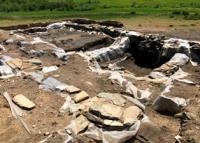Вы здесь
Ablaykit monastery.

Kazakhstan Silk Road Travellers.
“If diversity is a source of wonder, its opposite - the ubiquitous condensation to some blandly amorphous and singulary generic modern culture that takes for granted an impoverished environment - is a source of dismay. There is, indeed, a fire burning over the earth, taking with it plants and animals, cultures, languages, ancient skills and visionary wisdom. Quelling this flame, and re-inventing the poetry of diversity is perhaps the most importent challenge of our times”
Wade Davis.
Tour and Trips Kazakhstan.
Ablaykyt – the Junggar’s fortified Buddhist monastery of the XVII century. It’s a good sample of lamasery and is located in 60 kilometers far from the city of Ust-Kamenogorsk, 15 kilometers to south-east from the village of Bulanbay, Ulanskoe district of Eastern-Kazakhstan region, not far from the lakes of Sybynsk.
The monastery attracted attention of scientists from olden times. The monument was founded by Ablay, Junggar taishy. In the second half of the XV century western Mongolian tribes of the Junggars occupied Eastern Kazakhstan trying to establish big nomadic empire.
Taishy, Junggar feudal lords, attempted to capture the regions erecting fortresses and Buddhist temples. Following this in 1954 Ablay taishy erected fortress with Buddhist temple and liturgical library on the Kambynsk Mountains.
Part of the temple was burnt as a result of internecine wars between Junggar feudal lords. Remaining part with the library and fortress walls were left doomed for a slow destruction. The first description of the temple was made by the ambassador Fyodor Ivanovich Baikov, who was on a visit to Ablay taishy. He led Moscow delegation for negotiations with China.
Russian delegation was heading to Beijing through Ablays lands.
They gave Ablay “monarchic payment” and stayed there overwinter. After staying seven months and seven days they witnessed beginning of the construction of Ablaykit. Fyodor Baikov firstly notes and depicts ancient architectural buildings, stone wards and mansions.
This report was published in the middle of the 18th century by G.F.Miller in issues of the Academy of Science. Lately it was published by N.I.Novikov, G.I.Spasskyi, N.I.Ivanov, N.Sakharov.
Information about Ablaykit monastery is contained in books of Nicolaes Witsen, Dutch geographer and lawyer. Vasilyi Shishkov, Russian geodesist, drew the first plan and sketching map of the monastery in 1735.
Here were found manuscripts that laid foundation of the Asian museum in Saint-Petersburg. Short information about Ablaykit come from such scientist travelers of 18th century as Strahlenberg (1730), Müller (1750), Gmelin (1751), Pallas (1786) and Falke (1824).
In the first quarter of the XVIII century Peter I increased interest into Kazakhstan and Central Asia considering Kazakh steppes as “gates to all lands of Asia”. In this regard several expeditions were organized here including expeditions of I.D. Buchholz (1715 - 1716) and I.M.Lykharev (1720) to upstream waters of the river of Irtysh.
The monument became known to science in 1720 after Ust-kanemeogorsk fortress was founded and Peter I received manuscripts from Ablaykit. In 1811 G.I.Spasskyi, persevering antiquarian, visited Abkaykit and made detailed description of the monument and drawings of ruins, in which it is visible that walls of the temple and gates were preserved at that time. In 1826 Ledebour gave short description of the building.
All authors of the 19th century who expored geography and history of the Upper Priyrtishye – Levshin, Humboldt, Gulyaev, Kastanie, Semyonov-Tyan-Shansky – wrote about Ablaykit. Initially Ablaykit was a pentagonal formed building constructed of slate plates and granite pieces with clay mixture with walls of 3 - 5 meter high and 3 meter wide.
At present only external walls of the monastery were preserved as a square hill consisting of grey soil with big amount of brick pieces and clay water containers. There are also pieces of clay semicircular tiles and clay coverings.
Part of them is covered with blue, green and red enamel. Two middle-size pits are located in approximately 30 meters to north-west from the main hill. They resemble semicircular ditch and embankment with granite blocks.
The first pit have similar blocks with traces of fire. Lodging of lamas and persons of distinction represent heavily eroded square hill. It consists of solid, pieces of grey and red bricks. In other parts of the building there are no visible traces of construction.
According to the portrayal of the First Academic expedition of G.F. Müller Ablaykit consisted of three buildings: high temple with extensions built with white brick, lamas’ house with wooded second floor destroyed by fire and middle-size household room.
The first expeditions found many remains of statues, pictures, images of bodhisattva and dharmapala with nimbus, manuscripts in Mongolian in the place of the temple. Remnants of Ablaykit fortress yet attracted explorers of the region.
In 1935 - 1937 after Adryanov A.A. the monument was explored by archeologist S.S.Chernokov who made ocular plan of the monastery’s fortress. In 1980 guard plates were fixed, conducted revision of condition of the monastery and drawn schematic plan and prepared new documentation.
Exploration conducted by employees of the Eastern-Kazakhstan regional historical museum in 1990 represents current condition of the monument. Abkaykit have got considerable meaning in history.
Unfortunately, Ablaykit could not stand historical turbulence of many military battles. Its royalty completely disappeared. It wouldn’t be an exaggeration to note that for the first time ever Europe touched treasures of Buddhist literature thanks to findings in Altay.
Authority:
Historical monuments East Kazakhstan province. http://culturemap.kz
Photos
Alexander Petrov.







